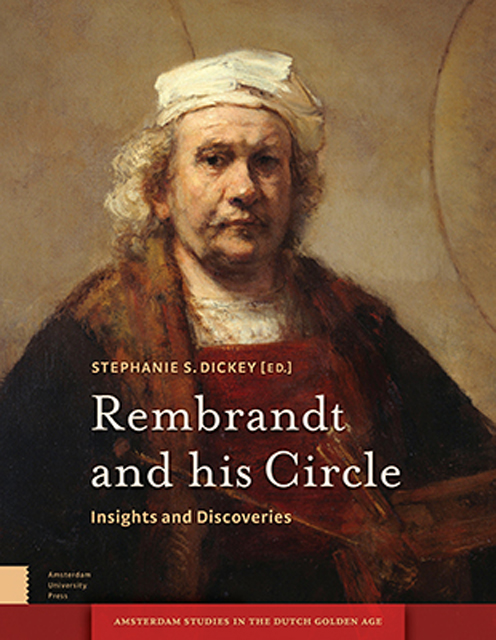Book contents
- Frontmatter
- Dedication
- Contents
- Acknowledgements
- Introduction
- 1 Rembrandt and Frans Hals Painting in the Workshop of Hendrick Uylenburgh
- 2 Rembrandt and the Germanic Style
- 3 Rembrandt and the Humanist Ideal of the Universal Painter
- 4 Curiosity and Desire: Rembrandt’s Collection as Historiographic Barometer
- 5 Painted Landscapes by Lievens and Rembrandt : The View from Seventeenth-Century Amsterdam Collections
- 6 Jan Lievens in Antwerp: Three Rediscovered Works
- 7 Gerrit Dou as a Pupil of Rembrandt
- 8 A New Painting by Jan van Noordt in Budapest
- 9 Rembrandt’s First Nude? The Recent Analysis of Susanna and the Elders from Rembrandt’s Workshop
- 10 Rembrandt’s Head of Christ: Some Technical Observations concerning Matters of Style
- 11 A Rediscovered Head of John the Baptist on a Platter from Rembrandt’s Studio
- 12 Rembrandt’s One Guilder Print: Value and Invention in ‘the most beautiful [print] that ever came from the burin of this Master’
- 13 Rembrandt, Ferdinand Bol, and Tobit: The Emergence of a Pathosträger
- 14 Biblical Iconography in the Graphic Work of Rembrandt’s Circle
- 15 Jan van Vliet and Rembrandt van Rijn: Their Collaboration Reassessed
- 16 Printmaking among Artists of the Rembrandt School
- 17 Chain Line Pattern Matching and Rembrandt’s Prints
- List of Illustrations
- Bibliography
- Index Nominum
2 - Rembrandt and the Germanic Style
Published online by Cambridge University Press: 21 January 2023
- Frontmatter
- Dedication
- Contents
- Acknowledgements
- Introduction
- 1 Rembrandt and Frans Hals Painting in the Workshop of Hendrick Uylenburgh
- 2 Rembrandt and the Germanic Style
- 3 Rembrandt and the Humanist Ideal of the Universal Painter
- 4 Curiosity and Desire: Rembrandt’s Collection as Historiographic Barometer
- 5 Painted Landscapes by Lievens and Rembrandt : The View from Seventeenth-Century Amsterdam Collections
- 6 Jan Lievens in Antwerp: Three Rediscovered Works
- 7 Gerrit Dou as a Pupil of Rembrandt
- 8 A New Painting by Jan van Noordt in Budapest
- 9 Rembrandt’s First Nude? The Recent Analysis of Susanna and the Elders from Rembrandt’s Workshop
- 10 Rembrandt’s Head of Christ: Some Technical Observations concerning Matters of Style
- 11 A Rediscovered Head of John the Baptist on a Platter from Rembrandt’s Studio
- 12 Rembrandt’s One Guilder Print: Value and Invention in ‘the most beautiful [print] that ever came from the burin of this Master’
- 13 Rembrandt, Ferdinand Bol, and Tobit: The Emergence of a Pathosträger
- 14 Biblical Iconography in the Graphic Work of Rembrandt’s Circle
- 15 Jan van Vliet and Rembrandt van Rijn: Their Collaboration Reassessed
- 16 Printmaking among Artists of the Rembrandt School
- 17 Chain Line Pattern Matching and Rembrandt’s Prints
- List of Illustrations
- Bibliography
- Index Nominum
Summary
Abstract
This essay draws from the writings of authors such as Franciscus Junius and Samuel van Hoogstraten to suggest that Rembrandt associated his artistic identity with the ancient Batavians, purported forefathers of the Dutch. Tracing the etymological association of ‘schild’ (shield) and ‘schilder’ (painter) and the fascination with Teutonic lore in Rembrandt's milieu, the author proposes an analogy between Rembrandt's increasingly blunt, direct manner of painting and the plainness of manner and speech associated with the Batavians. This analysis sheds new light on Rembrandt's Conspiracy of the Batavians under Claudius Civilis (Stockholm, Nationalmuseum), painted for the Amsterdam Town Hall.
Keywords: Rembrandt van Rijn, Franciscus Junius, Johannes Colaert, Tacitus, Nehalennia, Claudius Civilis, Roman Batavia, Teutonophilia, Amsterdam Town Hall (now Royal Palace)
Introduction: Rembrandt's Name
Raphael's and Michelangelo's names, which allegedly expressed the ‘angelic’ character of their works, may have reflected an element of their ambitions in self-fashioning, in a more pretentious manner than that by which Tintoretto's name stood merely for his dexterity with paints. North of the Alps, these Italians may in turn have been an example for Peter Paul Rubens, whose own last name could be derived from the Latin verb ‘rubere’, literally meaning being red or, more figuratively, blushing. The name ‘Rubens’ may have come to stand for a specific manner of brushwork, connected to the self-image the artist wanted to project: perhaps he focused on rosy flesh tints as one of his trademarks.
Like his predecessors who were known by their first names, the master from the Jodenbreestraat signed simply with ‘Rembrandt’. This essay explores a possible background for his choice. The name was idiosyncratic in the seventeenth century; an old Germanic word, Rembrandt meant ‘regal sword’. This article will suggest that when the artist highlighted his first name, he probably had his presumed Batavian forefathers in mind. This was not dissimilar to his pupil Samuel van Hoogstraten, who carried the nickname ‘The Batavian’, identifying him as descendant of the local tribe that had inhabited the Low Countries during the Roman occupation.
- Type
- Chapter
- Information
- Rembrandt and his CircleInsights and Discoveries, pp. 44 - 66Publisher: Amsterdam University PressPrint publication year: 2017



